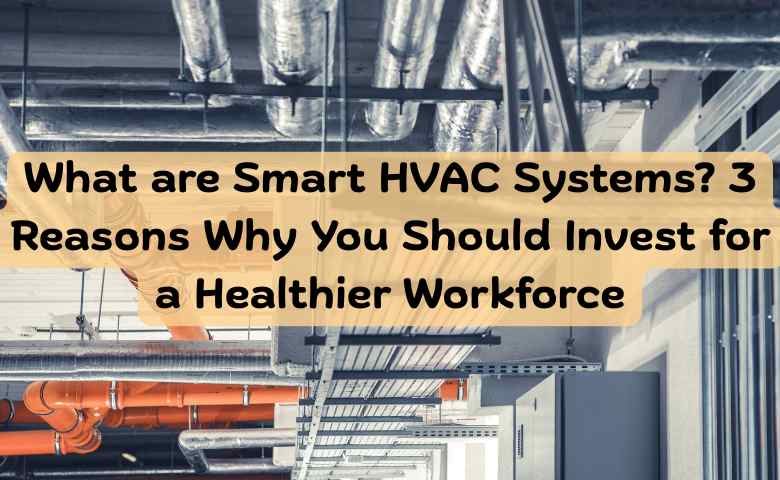Last Updated on July 15, 2025 by Admin
The average US worker takes three sick days per year. Research shows that there is a direct link between poor ventilation in the workplace and an increased risk of illness.
Improper ventilation and poor air quality contribute to the spread of airborne viruses and allergy-causing pollutants, two factors that impact absenteeism in the workplace. Worse still, a lack of ventilation and inadequate temperature control make for an uncomfortable working environment and a less productive workforce.
The introduction of smart HVAC systems in commercial spaces and office buildings aims to improve workplace well-being in 2025. With the ability to regulate temperature control and improve air quality, businesses that invest in smart HVAC technology are likely to foster a happier and healthier workforce.
Table of Contents
What is a Smart HVAC System?
HVAC stands for heating, ventilation, and air conditioning. In 2025, large-scale commercial buildings that cannot open windows will rely solely on mechanical ventilation systems to maintain air quality and control temperature.
Smart HVAC systems take air quality and climate control one step further. A smart HVAC system is intelligent. Equipped with advanced technologies, such as climate sensors and automated temperature management, these systems go beyond traditional HVAC models by adjusting settings based on real-time data.
From zone-to-zone climate control to IoT integrations that enable remote management, smart HVAC technology has been proven to improve comfort and convenience in the workplace.
Better still, experts at the US Department of Energy predict that smart HVAC systems alone cut energy consumption by 20-40%, resulting in lower utility bills for business owners and a smaller carbon footprint.
Why Proper Workplace Ventilation Matters
Adequate ventilation and climate control play a crucial role in maintaining a successful workplace.
HVAC systems are responsible for removing excess heat and preventing moisture buildup in a social space. This ensures that the working environment does not become overly humid and uncomfortable for workers.
In 2025, the recommended relative humidity for a workplace environment sits between 40% and 70%. It’s vital for business owners to maintain humidity levels within this range if they want to prevent discomfort, health issues, and productivity loss.
Proper workplace ventilation is also crucial for maintaining indoor air quality. Office spaces are often full of inbound viruses and pollutants, including fumes from cleaning products, emissions from office equipment, and germs circulating through the environment.
It’s important to be mindful of the impact these types of pollutants have on working conditions.
According to a recent analysis of ventilation rates and employee health, buildings with a lower ventilation rate have a 130% increase in sick leave.
3 Ways Smart HVAC Systems Revolutionise Working Conditions
Are smart HVAC solutions changing the game? As full-time office work returns five years after the COVID-19 pandemic, let’s take a closer look at the benefits business leaders could see when investing in a smart HVAC system in 2025:
Improved Indoor Air Quality
One of the most obvious benefits associated with investing in a smart HVAC system is improved air quality within the workplace.
Modern HVAC systems utilize high-efficiency particulate air (HEPA) filters and activated carbon filters to remove allergens and pollutants from the air, thereby enhancing air quality.
With the ability to also adjust ventilation rates based on building occupancy, humidity levels, and real-time air quality, smart HVAC systems reduce the concentration of harmful substances and prevent the growth of mold and mildew, known for triggering allergies and respiratory difficulties.
Improved ventilation and filtration systems have been known to also reduce the spread of airborne viruses such as the common cold, and even COVID-19, resulting in fewer sick days and a happier, healthier workforce.
Personal Climate Control
Another favorable feature of smart HVAC systems is personal climate control. When used alongside a building management system (BMS), HVAC technology can be tailored to suit employees from room to room.
Allowing workers to choose their own climatic conditions that suit their individual preferences, smart HVAC machines boost productivity in the workplace.
What’s more, these innovative systems also learn from user input. This means that once individuals add their own preferences, HVAC technology automatically adjusts future temperatures to directly align with user needs.
Increased Productivity
Studies have shown that breathing cleaner air and working in optimal humidity is the key to improving cognitive function in the workplace.
Smart HVAC systems help maintain a comfortable working environment, contributing to improved decision-making, increased productivity, and longer spans of concentration.
How to Maintain an Effective HVAC System in the Workplace
For businesses investing in smart HVAC technology, regular maintenance is essential.
The key here is to choose a contractor that also offers regular servicing for the best results. Most systems require annual maintenance; however, modern HVAC software for contractors makes it easier than ever before to connect field technicians to business operations for emergency call-outs and/or concerns.
Other maintenance tasks to add to the list include regular filter replacements to improve airflow efficiency and keeping vents and ducts clean for optimized ventilation.
Lastly, one of the easiest ways to ensure that an HVAC system goes the extra mile is to encourage good ventilation practices.
Encourage employees to regularly open windows, if possible, to improve natural air circulation and reduce the pressure on a mechanical ventilation system.
Wrapping Up
Optimized ventilation and temperature control in the workplace continue to play a significant role in workplace safety and well-being.
With the ability to reduce absences, improve cognitive function, and boost productivity, investing in a smart HVAC system is a no-brainer for business owners in 2025.
Related Posts
- What is HVAC? Career and Job Opportunities in HVAC [Updated Guide]
- Careers in HVAC: A Comprehensive Guide for Aspiring Technicians
- Top 50 HVAC Engineer Interview Questions (and Answers) for 2025
- HVAC Technician Job Description: Skills, Responsibilities, and Career Outlook
- How to Know if Your HVAC Technician is Screwing You Over (And How to Avoid It!)


